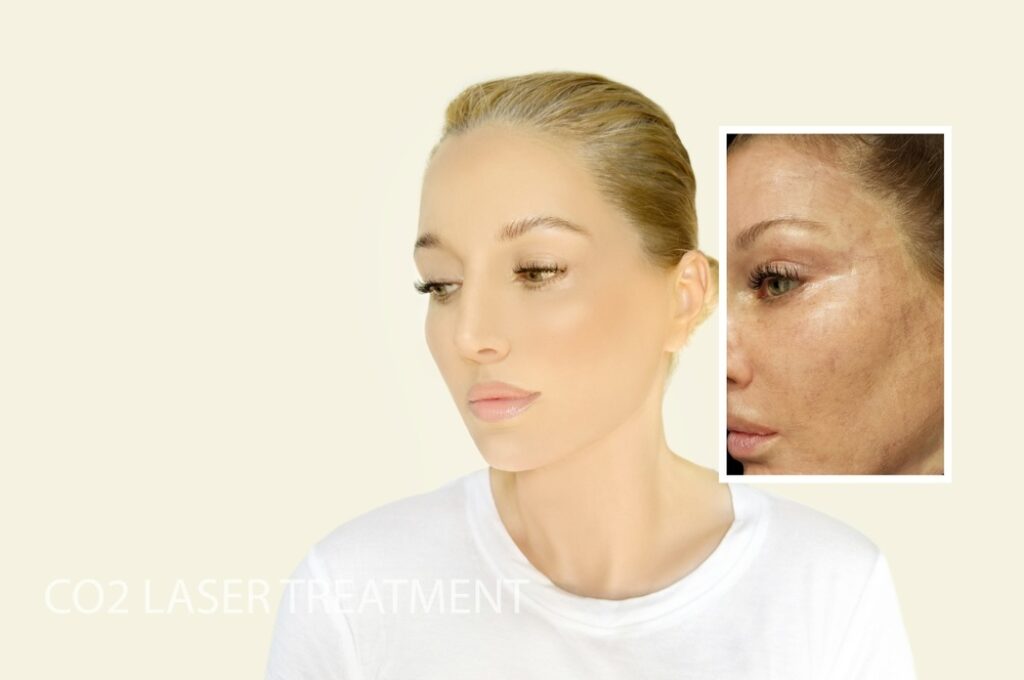
CO2 Laser Treatment
In the world of facial beauty and aesthetics, there are so many options for skin rejuvenation. From surgical procedures to topicals, it almost seems endless. CO2 laser treatment is a well known and trusted method for several reasons.
Related Topics (Sponsored Ads):
Carbon dioxide (CO2) laser treatment has a wide range of applications, making it a versatile tool in the arsenal of dermatologists and cosmetic surgeons. It is commonly used to address various skin concerns, including fine lines and wrinkles, sun damage, uneven skin tone and texture, acne scarring, and even certain precancerous lesions. By precisely targeting and removing the outermost layers of the skin, CO2 lasers can dramatically improve the overall appearance and health of the complexion.

Overview
CO2 laser treatment is a highly effective skin resurfacing procedure that has been used in the medical field for decades. This advanced laser technology targets the upper layers of the skin, precisely removing damaged or imperfect tissue to reveal the healthier, more youthful skin underneath.
The CO2 laser works by harnessing the power of light energy, which is absorbed by the water molecules within the skin cells. This absorption of energy creates controlled thermal damage, causing the targeted skin to vaporize while simultaneously stimulating the body’s natural healing response and collagen production.
Suitability Factors
Patients with a variety of skin concerns may be suitable candidates for CO2 laser treatment. The procedure is particularly effective for individuals dealing with signs of photoaging, such as fine lines, wrinkles, and age spots. It can also be an excellent option for those struggling with acne scarring, as the laser’s ability to remodel collagen can help minimize the appearance of indented or raised scars.
Additionally, CO2 laser treatment may be recommended for patients with uneven skin tone or texture, including those with enlarged pores, rough or dull complexions, and areas of hyperpigmentation. In some cases, the procedure may even be used to address precancerous skin growths known as actinic keratoses.
The best candidate for CO2 laser treatment typically have lighter skin tones. However, with the introduction of fractional CO2 laser technology, the treatment can now be safely and effectively performed on a wider range of skin types.
Benefits
One of the primary benefits of CO2 laser treatment is its ability to significantly improve the appearance of fine lines and wrinkles. By removing the damaged, aged top layers of the skin, the procedure stimulates the production of new collagen, which helps to plump and smooth the complexion. This can result in a more youthful, rejuvenated appearance, particularly around the eyes, mouth, and forehead.
Additionally, it has shown to improve the appearance of acne scarring, diminishing the look of both indented and raised scars. It can also help to even out skin tone by targeting areas of hyperpigmentation, such as sun spots and age spots, leaving the skin with a more uniform and radiant appearance. Furthermore, it can also enhance the overall texture and quality of the skin.
Risks and Potential Side Effects
While CO2 laser treatment is generally considered a safe and effective procedure, there are some potential risks and side effects that patients should be aware of. The most common side effects include redness, swelling, and mild discomfort or pain during the treatment and recovery process. Patients may also experience temporary changes in skin pigmentation, such as hyperpigmentation or hypopigmentation, which can occur as the skin heals.
In rare cases, more serious complications may arise, such as infection, scarring, or prolonged healing. Patients with certain medical conditions, such as active skin infections, autoimmune disorders, or a history of poor wound healing, may be at a higher risk of experiencing these complications.
To minimize the risks associated with CO2 laser treatment, it is essential for patients to follow all pre- and post-treatment instructions provided by their healthcare provider. This may include avoiding sun exposure, using specific skincare products, and taking any necessary medications to promote proper healing.
Recovery Process
The recovery process following CO2 laser treatment can vary depending on the extent of the procedure and the individual’s skin type and healing response. In general, patients can expect some degree of redness, swelling, and peeling in the days and weeks following the treatment.
During the initial recovery phase, which typically lasts 7-10 days, patients may experience a significant amount of peeling and flaking as the damaged skin is shed. This can be accompanied by mild discomfort, such as tightness or sensitivity in the treated areas. Over-the-counter pain medication and the use of gentle, fragrance-free skincare products can help manage these symptoms.
As the skin begins to heal, the redness and swelling will gradually subside, and the new, rejuvenated skin will start to emerge. Patients may notice initial improvements in skin texture and tone within the first week or two, but the full benefits of the treatment, including the reduction of fine lines, wrinkles, and scars, often become more apparent over the course of several weeks to months.
It is essential for patients to follow their healthcare provider’s post-treatment instructions carefully, which may include the use of sunscreen, avoidance of certain skincare products, and the scheduling of follow-up appointments to monitor the healing process.
Tips
When trying to decide on a C02 laser provider, it’s highly recommended to follow these tips:
~ Look for a board-certified dermatologist or plastic surgeon with extensive experience in performing CO2 laser treatments.
~ Ask about the provider’s specific training and expertise in using CO2 laser technology, as well as the number of procedures they have performed.
~ Inquire about the type of CO2 laser equipment used, as newer, fractional laser systems may offer improved safety and efficacy compared to older, fully ablative models.
~ Request before-and-after photos of the provider’s previous CO2 laser treatment patients to get a sense of the quality of their work.
~ Ensure that the provider thoroughly discusses the risks, benefits, and expected outcomes of the procedure, and that you feel comfortable with their approach.




